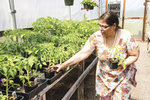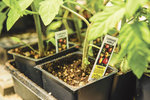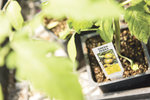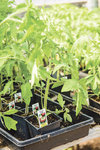



Few garden vegetables inspire gustatory bliss like a fat red tomato ripened in the sun.
According to the National Gardening Association, tomatoes are far and away the most popular vegetable for gardeners to grow at home. In fact, 86 percent of home gardeners said they would grow tomatoes in a given year.
There are good reasons for the tomato’s popularity. They are usually easy to grow, and just a few plants provide an abundant harvest for most households. Plus there is no comparison to biting into a sweet, juicy tomato still warm from the sun.
Chapman’s Greenhouse in Vancouver is something of a tomato specialist, with over 50 unique varieties grown from seed. Denise Wisell, sales manager at Chapman’s Greenhouse, explained that tomatoes are most finicky about temperature.
Her standard advice is to wait until after Mother’s Day to plant tomatoes outside, but in this unseasonably warm year, even her own tomatoes are already settled into the garden soil. The soil temperature should be over 60 degrees when you plant tomatoes, she says. Raised beds can be helpful, because the soil tends to warm up earlier in the spring.
Once tomatoes are in the ground, it’s not time to forget about them. They like protection from cool nights and rain. While they are small a 5-gallon bucket upended will do the trick; a larger plant can be protected with a plastic bag draped over a tomato cage. They don’t like water on their leaves, so aim the garden hose toward the dirt on dry days.
With all those varieties of tomatoes, how would you ever choose just one or two? There are a few easy ways to narrow the choices down. Do you want heirloom tomatoes, or hybrids? Heirloom varieties are revered for their superior flavor and juiciness, but hybrids have been bred to offer increased disease resistance. Wisell loves to grow heirloom varieties, and finds they thrive in her garden. She recommends dropping a cup of lime or a tablespoon of Epsom salts in each planting hole, to help the plant resist the most common tomato disease, blossom end rot.
Also consider the harvest season and size of plant. Tomatoes are either determinant or indeterminant. The determinant variety is shorter and bushier, and yields its harvest within a few short weeks. This is an advantage for canning and preserving but might be overwhelming for fresh eating. The compact nature of the determinant plant also makes it well suited to container growing.
The indeterminate tomato plant has a sprawling growth habit, and vigorous plants can reach heights of 6 feet or more. They yield their fruit (yes, tomatoes are technically a fruit) throughout the season, so you enjoy fresh tomatoes for months.
Usually when selecting young plants, a compact and bushy plant is more desired. But with the indeterminate tomato varieties, you can take a tall leggy plant, pluck off the lower few leaves, and plant the whole stem in the ground almost to the first remaining leaves. The site where leaves were removed will sprout new roots, and the plant will be more vigorous.
The biggest challenge for tomato gardeners in the Pacific Northwest is the short growing season. When forecasters offer predictions of an autumn frost, growers eye their still-green tomatoes with longing. It’s possible to eke one last harvest out of the plants, said Wisell. Pull the entire plant up by the roots and hang it upside down in a protected place like a garage or shed. The tomatoes will ripen on the plant within about 10 days, for one last taste of summer’s bounty.